The Apple iPhone 11, 11 Pro & 11 Pro Max Review: Performance, Battery, & Camera Elevated
by Andrei Frumusanu on October 16, 2019 8:30 AM ESTDisplay Measurement
When it comes to displays, last year's iPhone XS didn’t showcase any major display changes compared to the original iPhone X, as the two phones seemingly shared the same display panel. In contrast to that situation, for the new iPhone 11 Pros, Apple is advertising using a newer generation panel which brings notable improvements with it.
In terms of dimensions or resolution, there’s no visible changes on the new panels, and you’d have to look under the hood to see what has actually changed. The most notable improvement this year is a switch in the OLED emitter material that’s been used by Samsung in producing the new screen. The new generation emitter was first introduced in the display panel of the Galaxy S10, and to my knowledge it has subsequently only been used in the Note10 series as well as the new OnePlus 7T (regular version only). The iPhone 11 Pro phones now join this limited group of devices, and the biggest improvements to the user experience will be higher maximum brightness levels as well as improved power efficiency.
The regular iPhone 11, on the other hand does not seem to have changed much from the iPhone XR. It remains a relatively lower resolution LCD screen, although its display characteristics remain excellent.
We move on to the display calibration and fundamental display measurements of the iPhone 11 screens. As always, we thank X-Rite and SpecraCal, as our measurements are performed with an X-Rite i1Pro 2 spectrophotometer, with the exception of black levels which are measured with an i1Display Pro colorimeter. Data is collected and examined using SpectraCal's CalMAN software.

In terms of maximum brightness, Apple has advertised that the new iPhone 11 Pro’s can reach up to 800nits of brightness displaying regular content. We’re able to verify this, as our 11 Pro Max sample reached 807 nits while the 11 pro reached 790 nits. Consequently, it’s quite odd to see that the LCD-based iPhone 11 is now the lowest brightness device in the line-up. As always, Apple doesn’t make use of any brightness boost mechanism and thus allows its peak brightness to be achieved in any scenario.
Apple also advertises that the screen does go up to 1200 peak brightness in HDR content, however I haven’t been able to go ahead to verify this in our current test suite.
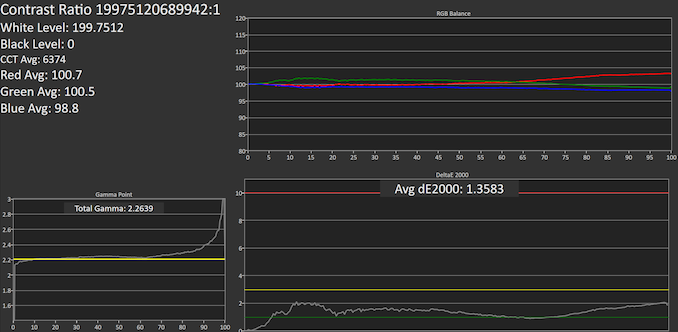
SpectraCal CalMAN
iPhone 11:
iPhone 11 Pro:
iPhone 11 Pro Max:
In the greyscale tests, all the iPhones perform extremely well, as expected. The Pro models do showcase a tendency to have slightly too strong red levels, so their color temperature is ever so slightly too warm. This characteristic diminishes the higher in brightness we go on the Pro models. The iPhone 11 has a weakness in the greens, so its color temperature is a above the 6500K white point target.
Gamma levels are excellent and target levels of 2.2. The Pro models are veering off towards higher gamma at higher picture levels, something that isnt as prominently exhibited by the iPhone 11. I’m not sure if this is due to a non-linear APL compensation of the phone screen during our measurement patterns, or if there’s an actual issue of the calibration.

iPhone 11 / SpectraCal CalMAN
iPhone 11 Pro / SpectraCal CalMAN
iPhone 11 Pro Max / SpectraCal CalMAN

The dE2000 deviation scores for the Pro models this year are slightly worse than what we saw in last year’s XS devices, however it’s still firmly among the best in class devices out there in the market, and you’d be hard pressed to perceive the small deviations. The iPhone 11 oddly enough does fare a bit worse off than the iPhone XR due to the larger deviations in color balance.
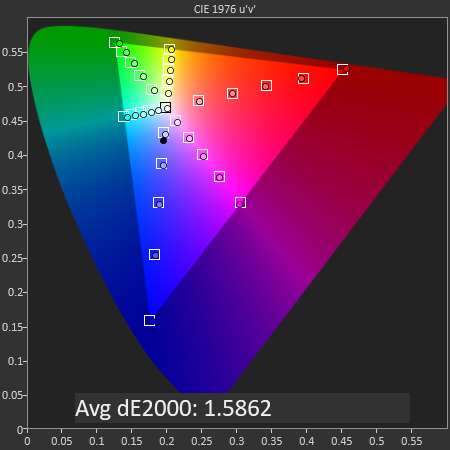
iPhone 11 / SpectraCal CalMAN
In the sRGB color space (default device content), the iPhone 11 performs extremely well with only minor shifts in hue in the greens.
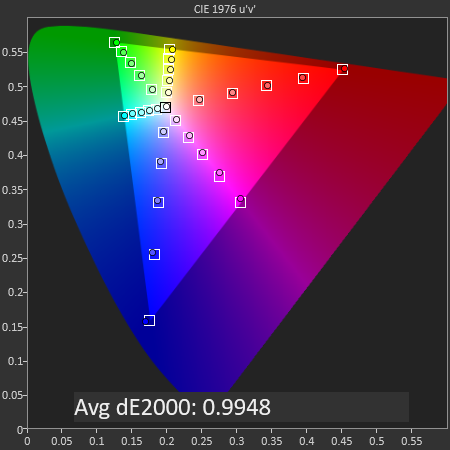
iPhone 11 Pro / SpectraCal CalMAN
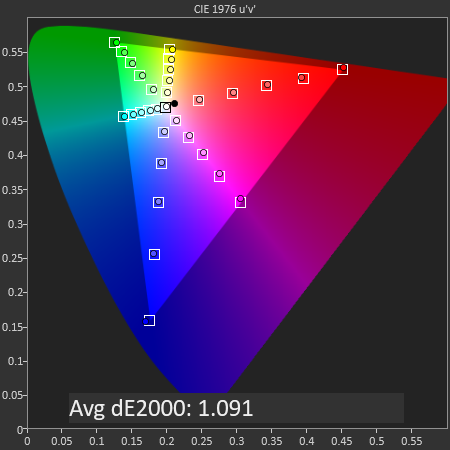
iPhone 11 Pro Max / SpectraCal CalMAN
In the same test, both the Pro models are showcasing exemplary accuracy.

The Pro models are just a bit worse off than the XS models of last year, but again these are among the most accurate displays you’ll find out there – mobile devices or not. The iPhone 11 is still excellent, although showing a bit larger deviation compared to the XR.
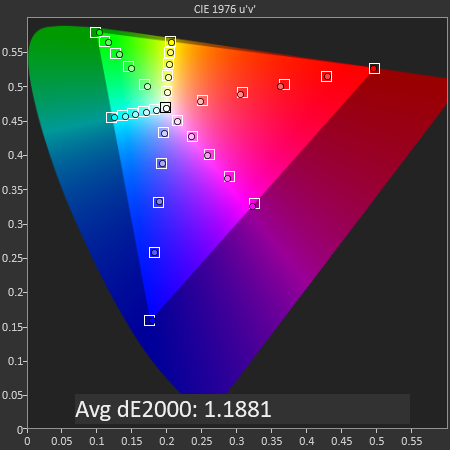
iPhone 11 / SpectraCal CalMAN
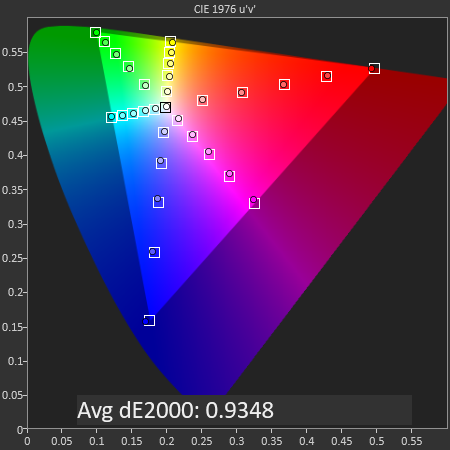
iPhone 11 Pro / SpectraCal CalMAN
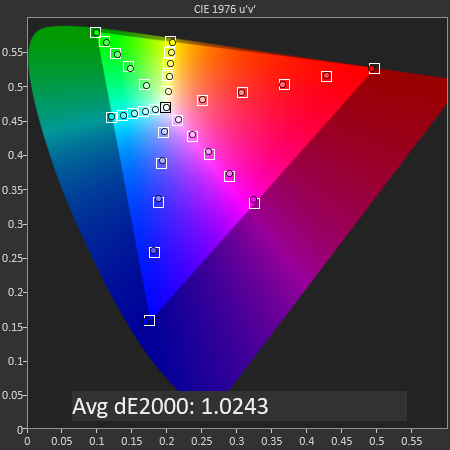
iPhone 11 Pro Max / SpectraCal CalMAN
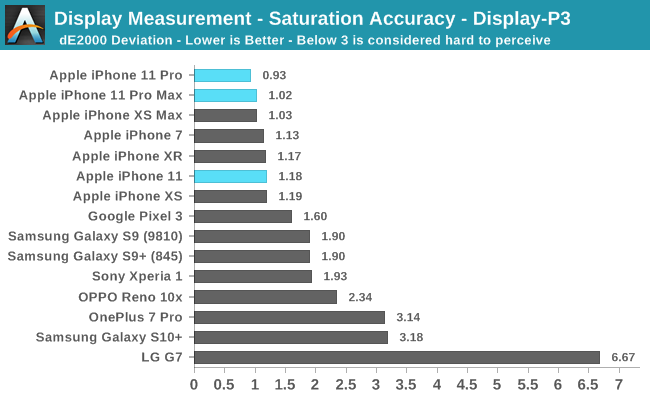
For Display P3 content, the iPhone 11 Pro models showcase the best saturation accuracies we’ve ever measured on any display. This time around, the iPhone 11 is in line with the XR.
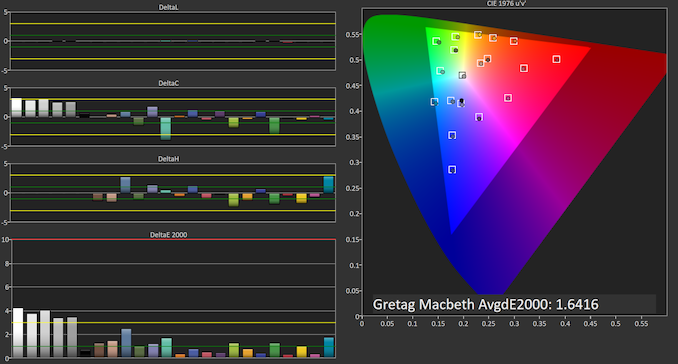

iPhone 11 / SpectraCal CalMAN
In the Gretag-MacBeth test of common tones, the only real issue of the iPhone 11 is the whites which had showcased a weakness of greens. Notice how the luminosity of the tones are essentially absolutely perfect.


iPhone 11 Pro / SpectraCal CalMAN
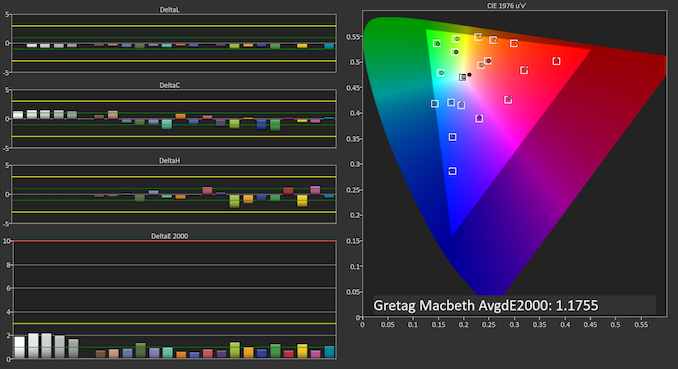

iPhone 11 Max Pro / SpectraCal CalMAN

Overall in terms of the color calibration and screen quality, the iPhones are the very best in the industry. There’s really nothing I can say about them as they’re class-leading in every regard.
The iPhone 11’s LCD screen isn’t for my taste due to the lower resolution, which frankly does bother me, and it certainly doesn’t have the same contrast characteristics as the Pro models. So while colors are still extremely good, it remains a compromise in 2019 when essentially every manufacturer has moved on to adopt OLED screens.
Display Power Measurements - Generational Improvements
Naturally, we didn’t want to finish the display evaluation section without verifying Apple’s claims about the new improved power efficiency of the iPhone 11 Pro panels.
Comparing the three generations of identical format iPhones, we again see that the display power consumption between the original iPhone X and the XS didn’t differ much at all. Plotting the new iPhone 11 Pro in the chart however we immediately see the difference in the new generation.
At equal brightness levels, Apple has indeed been able to improve the power efficiency of the panel by 15% - just as Apple’s marketing described it. We also see how the new panel expands past the brightness limits of the X and XS, reaching 800nits. This does come at a cost however, as the improved power efficiency isn’t able to completely make up for the larger brightness increase, so the maximum power consumption of the screen displaying full white does rise from 2.6W to 3.1W.


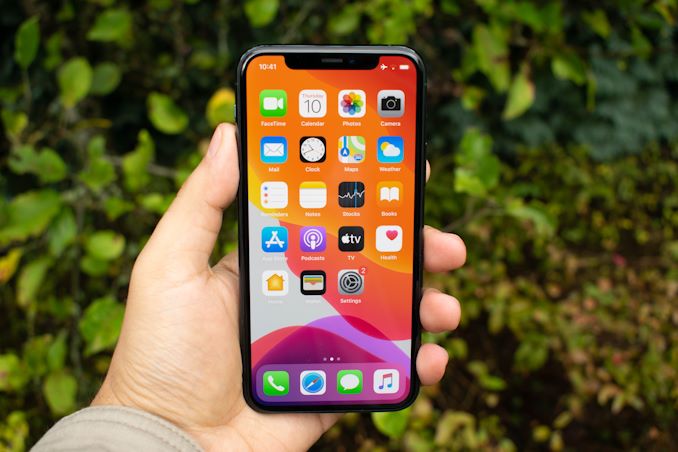









242 Comments
View All Comments
ksec - Wednesday, October 16, 2019 - link
Well At least one article got it right on Anandtech. Last time Anton refers Apple A13 as 7nm EUV, along with an TSMC update mentioning it as well. Now we can finally settle Apple is using N7P.I think one of the reason for the higher power usage is the A13 was designed with 7nm EUV in mind, and was only later changed to N7P as 7nm EUV may not provide enough capacity for Apple.
I do wonder if we are going to see 5nm Apple SoC next year.
Ian Cutress - Wednesday, October 16, 2019 - link
Anton didn't realise 'N7P' and 'N7+ with EUV' were different processes - and that people were using P instead of + for some unknown reason. Up until a while ago, any time someone said 'second generation N7', it was always thought of as N7+. Now we're making them clarify.FreckledTrout - Wednesday, October 16, 2019 - link
It's TSMC's alphabet soup so who can blame him. They could make the node names a bit easier for people whom are not CPU process nerds.dennphill - Wednesday, October 16, 2019 - link
Apple! They just give you what THEY want to! Pretty disappointed in all their products. I finally gave in and got rid of my Goggle thinggie (worthless, really) and got a reconditioned iPhone 8+ a coouple of months ago. It is really (so here's my technical user review: "It's just...") OK. My wife, OTOH, has an SE - her second - and she really doesn't want anything bigger. EVER! (Listen to that, Apple!) Even the reported new 'tiny' 2020 5.4" iPhone is what she calls HUGE. Weekend project is replacing her iPhone 5 SE battery that's begun not to keep a charge.peevee - Wednesday, October 16, 2019 - link
Make your bets: will Apple switch to A13X in their MacBooks... Seems would be very prudent with an 8-core implementation.solipsism - Wednesday, October 16, 2019 - link
I have no doubt Apple will replace Intel with an ARM SoC, but I do not expect it to be beefed up A-series chip found in an iPhone. Just like all their in-house designed chips, I would expect it to be its own letter designation with considerably more memory bandwidth, access to PCIe, and other features that work well in a lower-end portables and desktops.Diogene7 - Wednesday, October 16, 2019 - link
I hope Apple intend to keep their future laptop ARM CPU low power enough to not require any active cooling : a fanless ARM mac laptop is well executed could have a lot of appeal to me !!!That the reason why at the moment, I am keeping an eye on Samsung Galaxy Book S / Microsoft Surface Pro X that are the 2 first fanless computers with ARM Qualcomm 8cx : if responsiveness is good enough (especially for web browsing, watching video, Microsoft office,...) then it would prove it is possible.
From there, I would be very happy that Apple do an always connected fanless Macbook Air with an ARM CPU, as otherwise I am considering buying a Qualcomm 8cx fanless laptop (if the reviews confirms that the performance are reasonable enough)
joms_us - Wednesday, October 16, 2019 - link
I like to have this as well, approx. 1 day battery able to do media consumption/productivity. At least the comparison so far is that it is better if not than Intel Core i5-8250UQuantumz0d - Thursday, October 17, 2019 - link
This mentality shift that Apple caused in consumers is the reason why Laptops got rolled over into thin anf light disposable garbage.All Intel BGA / AMD (both PGA and BGA) all have castrated TDP limits which forces throttling. And Apple shoved an 6C/8T into which they cant cool because they tried to cheat physics. And still after VRM fiasco they still put the 8C/16T into that anemic chassis people who are buying them deserve to be robbed off th e 60% drop in performance.
Dell shoved XPS with same i9 and it got rekted down. Surface ARM cannot run 64bit x86 code and iy can run the UWP garbage only.
Next the BGA hellhole that Apple dragged everyone into. First x86 macs had BGA processors. Seeing that Intel stopped PGA and started Ultrabook BS and killed off all MX and XM PGA from Haswell making BGA with cTDP mandatory and bins locked down. My Haswell CPU in Notebook maintains consistent 700 in CB R15. Not even 7700HQ does it when put in a TDP locked JUNK.
And next Soldered SSD in Macs paired with T2 chip. Anything goes bad Go to Apple. Battery soldered to Chassis. KB inherent design flaw. This stupid corporate only knows how to fleece and put junk and forced all companies passively into this thin and light garbage.
Forget PCIE NVME SSDs in RAID rhat chassis will melt and GPUs don't exist in Apple lala land because Muh AR ML Kit and all.
ARM cannot do Transcoding work. Period. And Image Processing like Autodesk won't run on garbage ARM GPUs need Nvidia chips with High BW GDDR6 or G5X. Apple cannot cool them in that chassis. They can't escape Physics. End of Story of this A series competing with x86 ISA and Intel/AMD.
Diogene7 - Thursday, October 17, 2019 - link
@joms_us : Yes, for applications compiled to work natively on ARM64, the performance of the app running a Windows computer with Qualcomm 8cx should be similar as the same x86-32bits app running on a Windows computer with Intel Core i5-8250U, but with the advantage of having much better battery life which is appealing to me as well :).Really looking forward to read reviews on Samsung Galaxy Book S and Microsoft Surface Pro X to see if they hold to the hype...